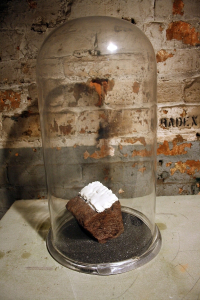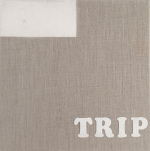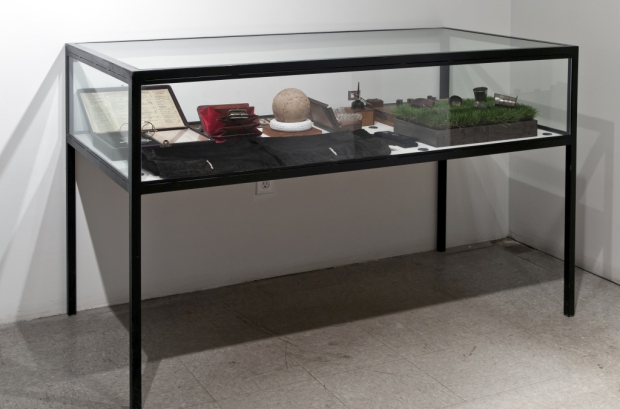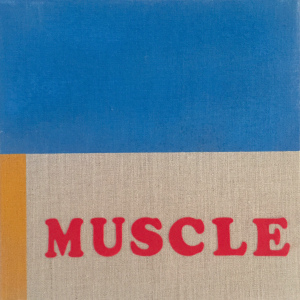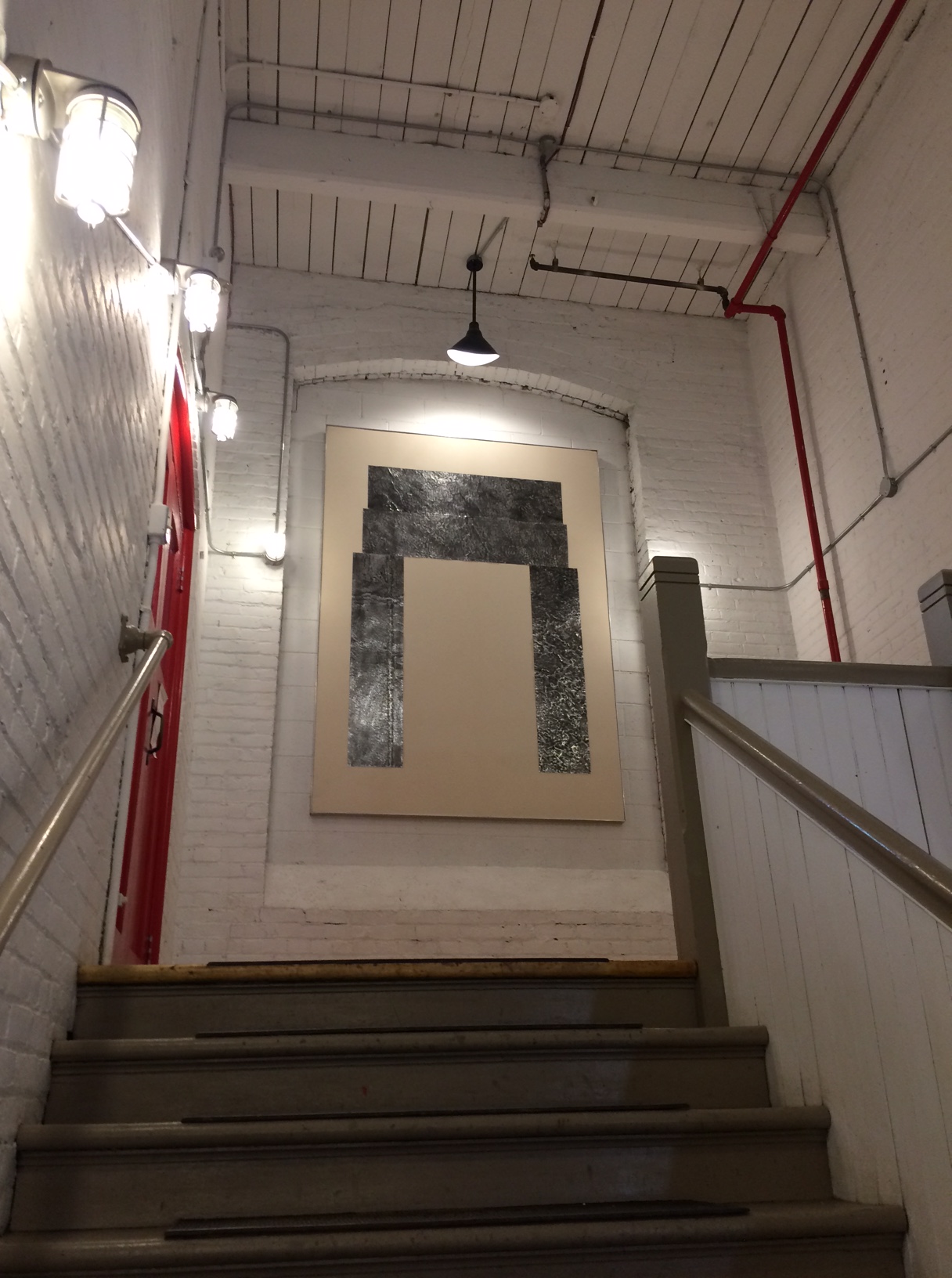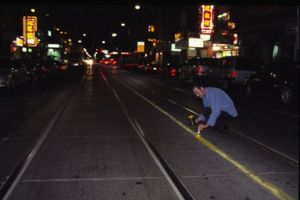by Mark Cheetham
To be different from our everyday lives, yet to make a difference in them, works of art need to be at once approachable and strange. We require a connection — otherwise, we literally won’t see — but there is little point in going exactly where we have been before. For progressive contemporary painters, the familiarity of the medium is a virtue that must also be challenged. Much of Wells’ work in 1911 seems familiar as painting, at least to those schooled in the art history of the last fifty or so years. At a glance, it looks like formalist abstraction. For example, homophone (ks,x), from the series titled yellowyellow (2000), is strikingly reminiscent of Claude Tousignant’s double banded yellow monochrome Hommage à van Gogh (1956). Were they hanging side by side, we would of course also notice many subtle differences: size, a horizontal versus vertical format for the yellow bands, and the equality of the expanses of yellow in the Wells versus the smaller yellow strip at the top of the Tousignant. Similar as they nonetheless look, these paintings don’t speak the same language. Where the Tousignant locates its homage in a radical distillation of van Gogh’s signature yellow pigment, Wells’ painting is decidedly anti-formal. In its unwavering regard for society and its norms, it is what he deems “post-aesthetic.” While his work is decidedly material – taking road lines, which Wells thinks of as Painting’s found object – into an art context, the work is for the same reason wedded to a tradition of Conceptualism.
On what grounds might we claim that two works that look so neighbourly can be seen to inhabit very different worlds? We know, and can only know, by context. On their own, like words without a sentence, paintings as reductive as these don’t tell us much about their possible interpretation. But neither are they meaningless or unchanging. Wells’ work trades on how context drives change, how a familiar semiotic system — the yellow, white, blue, black (and, very rarely), red, paint markings on roads and highways — gets us from one place to another without arousing much attention. His exploration is a conceptual in its consistent attention to understanding and finding schematic equivalents for the system, but it is, again, material in its rigorous restriction to the materials of road marking itself: the special line marker paint, the small vocabulary of shapes and widths, the restricted palette — chosen for its visibility — that, ironically, we usually only attend to peripherally. Wells’ art is figural in its attention to landscape motifs yet also abstract in its historical and semiotic reference points. His pieces are anti-mimetic in the sense that he transposes rather than reproduces the line markings. But the resulting paintings, photographs, performances, and texts are at the same time post-aesthetic because they can never remain in such an autonomous realm of contemplation. Wells’ art is never far from the social concerns of travel, borders, and permissions. He paints over these social lines so that we may better see them. Reminiscent of Robert Smithson’s dialectic of site and non-site, in 1911, what is outside art (road painting) crosses a line to the inside (the fine art of painting or photography), but only temporarily and conditionally.
It is one of the paradoxes of the genre that painting over, or “over painting,” can suggest either the erasure or accentuation of a painterly mark. One can paint over a mistake or revise a motif in a canvas and show something else entirely, or one can build up the pigment to emphasize one area. Road marking tends to the latter route, as Wells’ reminds us by re-painting these lines in the hand loves that which is hard, #1, virtual (2000-02). Here he develops his initial image of a road line from the Trans-Canada Highway near Banff, Alberta in 1996 into an ongoing performance, a 10-panel, ink-jet series in which the same road and line are placed in stereotypical landscapes in each Canadian province. His line re-painting in situ on the McMaster University campus for this exhibition is part of this continuing series and underlines the fact that road lines are both highly specific to a place and instantly generalizable, both geographically and by medium. These humble sequences perform their delimiting safety functions without drama: line marker paint can appear to be the same, and function in the same way, in very different places. We have no trouble believing that the “same” line belongs in a road scene from B.C. or Newfoundland. Wells calls attention to this necessary anonymity in what amounts to a portrait of the road line and his performance of its semiotic life: PLEINAIRISME (2001-02). Taken from a high vantage point, a large, sharp-focused photograph shows the artist, back turned to us, working on a large, horizontal canvas. His subject? A line that poses cooperatively in the distance. Using line marker white paint and observing the protocols of width and saturation set in municipal road regulations, Wells portrays this line. The nearly contiguous elements of this two-part work provide context for one another: we cannot go far in thinking that the canvas makes reference to either a materialist or transcendental strain in the history of abstract painting — no Newman zip here; Klee’s quip that art is taking a line for a walk would also acquire new meaning — because the photo brings us back to “reality.” Yet its quotidian existence, a line that we would walk across as a pedestrian or drive beside as a motorist with equal oblivion, is temporarily held open to conceptual inspection.
Wells moves road marks into the aesthetic sphere to encourage us to see them more completely. Typically, if we see them at all, it is when we are moving and when, in a sense, they move us from point to point. Thus in parcel the journey with the destination (2001-02), a large photo mural of another, almost clichéd northern landscape, is overpainted with the codes of line markings. The transition from yellow lines to white, if we pay attention, means we have moved from highway to town markers. A curve suggests that we can leave the road entirely and arrive. The system works in reverse upon departure. In seeking “unspoiled” nature, we move via the acculturated norms of the road. Our attention to this system is, again, brief at best, though Wells slows the pace for us here and again in a more overtly time-based piece whose title plays with that of the exhibition: nein, teen 11 (2001-02). Here Wells adopts a unique vehicle for his meditation, a “Rotographic” advertising board whose pyramidal bars rotate in unison to give us three related but discontinuous texts. Trying to read any one of the sequential texts that Wells has painstakingly applied to each bar can be frustrating because he has put far too much text on the accumulated surface. The machine inevitably accomplishes its interruptive move to the next panel before we have time to read many lines. Wells has calculated that it would take about forty minutes of sustained viewing — and an excellent short-term memory — to read the entire, 900-word sign completely. We travel with the text here, just as we do with the lines Wells writes about in this piece and both photographs and paints in others.
The first road marker lines were painted in 1911. Wells has re-painted (or painted over) a section of this original site in a homage performance, reclaiming a history in Trenton, Michigan, where these first lines were set down. In the exhibition 1911, we see his typically filtered versions of this memorial activity. The number eleven, he muses, is in a sense a portrait of the common double road line. We see this image in the most abstract-looking of the paintings in this exhibition: threeway (2000). Part of the yellowyellow series, this painting also builds on Wells’ 1998 two ways of achieving an end. Instead of two double line “elevens,” here we have three. Each “way” is strictly instrumental, a technique for marking a road’s median, of warning drivers where their permission to travel ends. In the southwestern U.S.A., Wells discovered, the blending of road, earth, and sky has necessitated the bold edging of a black line inside two yellows that we see on the left in threeway. Moving from left to right across this image, and also both geographically and temporally, we then see the most familiar portrait, the double yellow line. This version, however, is painted in the original yellow oil line marker paint. A newer version of this line marker paint, a yellow latex pigment, is seen on the right. In homophone (ks,x), Wells puts the two paint types side by side, with equal emphasis, so that one can see their subtle differences, their different “ways.” The oil and latex yellows serve the same function on the “thruway” whose name he invokes, but in a painting, their discrimination matters.
Painting Ends (2000-01) places the two yellows in a temporal display of literal over painting. Transposing two curb ends, each the standard six inches wide, Wells has painted latex yellow over the “older” oil, leaving overlaps to remind us of the painting over practices that we can see on the road itself, traces reamaining as uses change or perimeters need to be re-marked. As in TRENTON (2001), where lines from the road reveal their new inhabitation of high art painting by fitting perfectly within the panels’ boundaries, the “ends” here are schematic. They function as repeatable templates. Wells typically mixes historical research with conceptual questioning. He found out from a road painter in Calgary that lines, ends, and the like were, in the 1950s and before, set down by hand, using wooden templates. But Painting Ends is not produced this way, nor does it refer solely to road painting. In this worldly genre, an “end” is a limit or perhaps a functional goal. In the history of abstract painting especially, “end” connotes a terminus, a point of either futility or transcendence that has been envisioned in monochrome painting since Malevich’s Suprematism and Rodchenko’s materialism. These speculations on the end of painting took place within a decade of 1911 and have been renewed several times since. Thinking of how Wells’ paintings, photographs, and performances link the everyday world and that of painting’s habits and traditions, however, we might well ask what his work can say about Painting’s ends, its role and purpose within the social. To this purpose, let me imagine a rotographic text piece that takes off from PLEINAIRISME, one that — following Wells’ punning practices — I will call Plain/Heir/Ism.
In his two-part work with this name and in the exhibition generally, Wells plays with the tradition of painting outdoors, en plein air, in front of the motif, that we think of as quintessentially French. But as we have seen, he constantly schematizes, moves, and thus examines the ultimate outdoor painting, that done with line marker paint, by bringing it indoors and into “art.” Substituting “plain” for “plein” suggests the connection to the semiotically saturated social world we live in, with its often invisible rules, boundaries, and materials. Plain is unpretentious but not unsophisticated: a new latex yellow superseding a slower-drying oil. The line we see in PLEINAIRISME, framed by foliage and then by canvas, is plain in these ways. It works. “Heir” is of course what painting today is as a genre, the inheritor of high art traditions. One does not need to paint consciously in the wake of these habits and reference points to have them figure in contexts of reception. To produce the abstract work in 1911 is to work in a line of production that includes the monochrome, field painting, formalism, Conceptualism, and even the diagrammatic realities of Peter Halley’s conduits. In the same way, contemporary painting cannot but be the heir of many “isms,” from the sweeping ones such as Modernism and Postmodernism, to those with more local inflections and varying suffixes. Especially when one paints in a way that looks abstract, “heir” and “ism” pull towards a separate world of aesthetic priorities and concerns. But in Wells’ practice, “plain” keeps the social in our minds. Or perhaps he reminds us that the social has, more often than not, been in view in abstraction. Mondrian designed Neo-Plasticism to function as a template for ideal relations in society. Even Clement Greenberg, seen so often as the arch formalist, wrote in his early essays that art needed to retreat to its own presumably autonomous realm in order, ultimately, to lead society once more. Even when an artist does not intend a work to have social meaning, it may turn out to figure in this context. Think of the spectacular career of Newman’s Voice of Fire (1967), which was a touchstone of American cold-war liberty in the American Pavilion at Expo ‘67 and then the butt of public outcries when purchased by the National Gallery in Ottawa just over a decade ago. Contexts and meanings change, as we see in the movement from the road to the gallery and back in Wells’ work generally. Walking or driving down the street, we may well reconceive the evanescent social life of abstraction.

